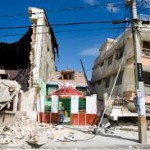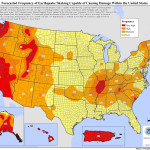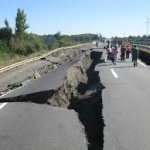Video above prepared by the State of Utah and discusses the results of a 7.0 magnitude earthquake along northern Utah’s Wasatch Front.
10 Ways to Prepare for an Earthquake
Earthquakes are among the most common natural disasters. Many large cities around the world are in active earthquake zones. Los Angeles, San Francisco, Tokyo, Manila, Quito, Delhi, Istanbul, Kathmandu, Mexico City, Kobe, Port Au ’Prince, and Santiago are among cities with millions of inhabitants who have experienced major earthquakes that have taken countless lives and destroyed property, sometimes leaving entire areas devastated.
Do I live in an earthquake zone?
You could live in an earthquake zone and not event know it. In 2014 the USGS revised its map of earthquake zones for the United States. These maps indicate earthquake hazard areas within the next 50 years. Some areas that were previously considered not prone to earthquakes were added due to earthquake activity in the last decade. See map at right.
Many parts of the world that are prone to earthquakes are the Pacific Rim (Asia, Pacific Islands, the entire western cost of the Americas) sometimes referred to as the “Ring of Fire”, parts of Russia, the Middle East (Iran, Iraq, Turkey), are among the most active. Recent Maps identify the most regions of the world with the most frequent and severe earthquakes.
Source: www.seismo.ethz.ch/static/GSHAP/
Loss of services
When sever earthquakes occur, the many common services may be interrupted. Clean water may not be available. Electricity may be interrupted. Food may not be readily available. Roads may be unpassable. Transportation corridors may be easily damaged in a strong quake. Communications are interrupted. Telephone or mobile phone services may be overwhelmed or unavailable. Public safety and medical resources (Police, Fire, Medical/Hospitals, etc.) are often overwhelmed in natural disasters and may not be available to assist for some time. Be prepared to be on your own for a time.
Top 10 tips to prepare for an earthquake
- Prepare an Earthquake Emergency Kit for each person in your family
- Create an emergency communication plan to contact people in your family or circle of friends
- Fasten shelves, wardrobes, and tall furniture to walls; place heavy objects on lower shelves. Fasten mirrors, pictures, large frames, and heavy items to walls and away from walls, beds, chairs, and sofas, etc.
- Store glass objects & china in low, closed cabinets (if possible use latches). Brace top heavy objects and overhead fixtures
- Eliminate fires risks by having professional help to repair defective electrical wiring and leaky gas connections. Consider flexible pipe fittings to avoid gas and water leaks. Do not do this work yourself
- Keep harmful chemicals and flammable materials on bottom shelves with latches
- Secure water large appliances such as water heater, furnace, refrigerator, and gas appliances by strapping them to wall studs and bolting to the floor
- Have your home professionally inspected for cracks in ceilings, foundations, and structural issues. Ensure your structure is secured to the foundation
- Hold regular earthquake drills. Practice: Stop, cover, hold on. Locate safe spots in each room.
- Become familiar with first aid, CPR and other basic lifesaving procedures.



